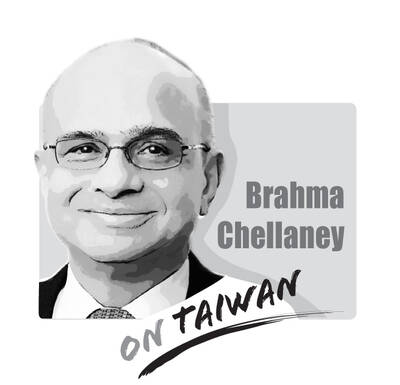Earlier this month, Legislative Speaker Wang Jin-pyng (王金平) said that because of the Democratic Progressive Party's (DPP) name-change policy and the Chinese Nationalist Party's (KMT) stolen assets issue, voters in southern Taiwan would not vote for a Mainlander president. Wang's remark both highlights ethnic differences and widens the rift between northerners and southerners.
According to a recent Taiwan Thinktank survey, the percentage of Taiwanese who believe that ethnic tensions have increased has risen drastically over the past 12 years, from 17 percent in 1995 to 31.9 percent in 2003, 55.9 percent in 2004 and 57.3 percent this year. Meanwhile, the percentage of people who believe that ethnic tensions have fallen has dropped from 63.3 percent to 36.1 percent during the same period. These statistics indicate that Taiwanese society feels the ethnic issue is no trivial matter and that it requires in-depth analysis and action.
This is how Taiwanese society in general views the political map: Southerners support the pan-green camp and Taiwanese independence, while northerners support the pan-blue camp and unification with China; people of Chinese origin are for unification, while Hoklo Taiwanese are pro-independence; DPP and Taiwan Solidarity Union (TSU) supporters are for independence, while New Party supporters are the strongest supporters of unification, followed by People First Party (PFP) supporters; and KMT adherents can be found somewhere between the New Party and the DPP.
Although some of these stereotypes are correct, another recent survey by the same think tank surprisingly shows that most of them are wrong.
Defining a pro-Taiwanese independence stance as the belief that the Republic of China's (ROC) sovereignty belongs to the 23 million people of Taiwan rather than China's 1.4 billion people brings some surprising results.
First, 76.1 percent of respondents believe the sovereignty of the ROC lies with Taiwan's 23 million people, while only 15 percent include China's population. Additionally, 85 percent of 20 to 30-year-olds and 80 percent with a university degree or higher education favor independence.
What is surprising is that only 24.7 percent of people of Chinese origin favor unification, while 70 percent say the ROC's sovereignty resides with the 23 million people of Taiwan alone. I find this astonishing. I was further astonished that 27 percent of Aborigines favored unification, the highest percentage of any ethnic group, while only 45.7 percent said they want an independent Taiwan, the lowest of any ethnic group.
Most people probably thought that with the concentration of people of Chinese origin in the Taipei-Keelung area and the strong voter support for the pan-blue camp, pro-unification sentiment would be the strongest there. The fact is, however, that 80.4 percent of respondents in this area believe that sovereignty belongs to the 23 million people of Taiwan, topping the rest of the country, while only 76.9 percent of respondents living in Yunlin, Chiayi and Tainan counties -- all seen as pro-independence strongholds -- said the same thing.
This very interesting survey explains that the relationships between Taiwan's regions and ethnic groups are very different from the stereotypical view held in some political circles.
On one hand, this is worrying because politicians are unaware of this. On the other hand, it is a cause for celebration because it means there is no absolute and predetermined relationship between region, ethnicity and a pro or anti-independence stance, which means that information and education can put Taiwan back on track.
Lin Cho-shui is a former Democratic Progressive Party legislator. Translated by Daniel Cheng
Recently, China launched another diplomatic offensive against Taiwan, improperly linking its “one China principle” with UN General Assembly Resolution 2758 to constrain Taiwan’s diplomatic space. After Taiwan’s presidential election on Jan. 13, China persuaded Nauru to sever diplomatic ties with Taiwan. Nauru cited Resolution 2758 in its declaration of the diplomatic break. Subsequently, during the WHO Executive Board meeting that month, Beijing rallied countries including Venezuela, Zimbabwe, Belarus, Egypt, Nicaragua, Sri Lanka, Laos, Russia, Syria and Pakistan to reiterate the “one China principle” in their statements, and assert that “Resolution 2758 has settled the status of Taiwan” to hinder Taiwan’s
Singaporean Prime Minister Lee Hsien Loong’s (李顯龍) decision to step down after 19 years and hand power to his deputy, Lawrence Wong (黃循財), on May 15 was expected — though, perhaps, not so soon. Most political analysts had been eyeing an end-of-year handover, to ensure more time for Wong to study and shadow the role, ahead of general elections that must be called by November next year. Wong — who is currently both deputy prime minister and minister of finance — would need a combination of fresh ideas, wisdom and experience as he writes the nation’s next chapter. The world that

Can US dialogue and cooperation with the communist dictatorship in Beijing help avert a Taiwan Strait crisis? Or is US President Joe Biden playing into Chinese President Xi Jinping’s (習近平) hands? With America preoccupied with the wars in Europe and the Middle East, Biden is seeking better relations with Xi’s regime. The goal is to responsibly manage US-China competition and prevent unintended conflict, thereby hoping to create greater space for the two countries to work together in areas where their interests align. The existing wars have already stretched US military resources thin, and the last thing Biden wants is yet another war.
Since the Russian invasion of Ukraine in February 2022, people have been asking if Taiwan is the next Ukraine. At a G7 meeting of national leaders in January, Japanese Prime Minister Fumio Kishida warned that Taiwan “could be the next Ukraine” if Chinese aggression is not checked. NATO Secretary-General Jens Stoltenberg has said that if Russia is not defeated, then “today, it’s Ukraine, tomorrow it can be Taiwan.” China does not like this rhetoric. Its diplomats ask people to stop saying “Ukraine today, Taiwan tomorrow.” However, the rhetoric and stated ambition of Chinese President Xi Jinping (習近平) on Taiwan shows strong parallels with